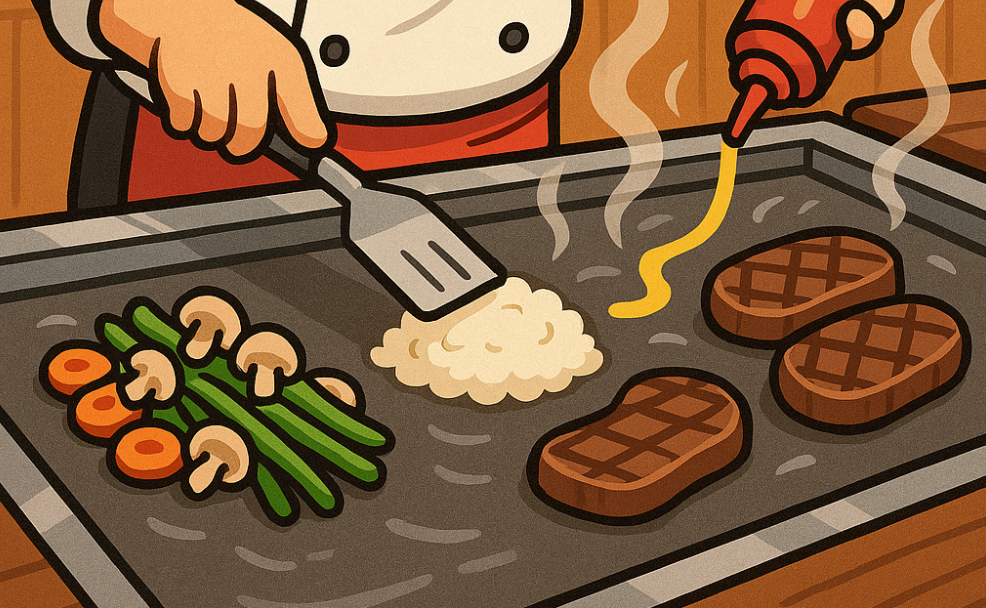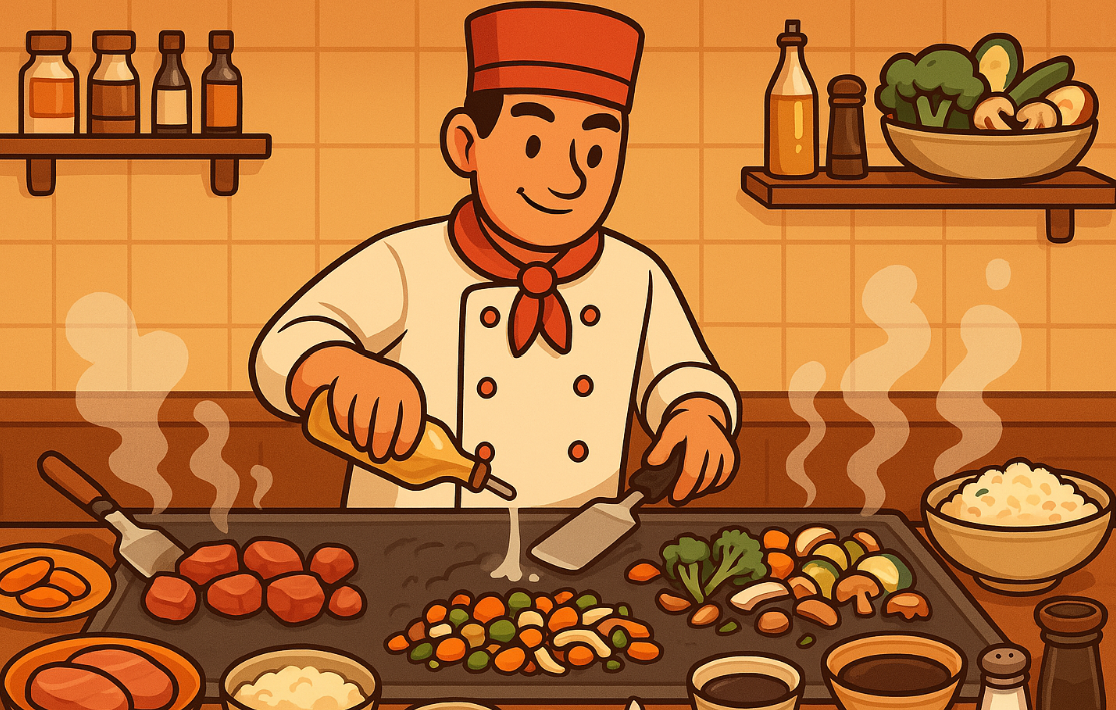DIY Hibachi: Sizzling Flavors in Your Own Kitchen (or Backyard!)
The allure of hibachi is undeniable: the dramatic flair of the chef, the communal experience, and most importantly, that incredible, savory flavor packed into simple ingredients. While dining out is a treat, you might wonder if you can replicate that deliciousness at home, perhaps even creating a cheap hibachi experience without the restaurant price tag. Good news: you absolutely can! While you might skip the onion volcano (or maybe not!), capturing the essence of hibachi cooking is achievable with the right tools, ingredients, and techniques.
This guide will walk you through cooking hibachi by yourself, transforming your kitchen or backyard into your personal teppanyaki stage.
Gearing Up: What You Need for Home Hibachi
You don't necessarily need a built-in restaurant-style griddle. Here are some accessible options:
The Heat Source: High, consistent heat is key.
Outdoor Flat-Top Grill (like a Blackstone): This is arguably the closest you'll get to the restaurant experience at home. The large, even surface is perfect for cooking multiple ingredients simultaneously and achieving that signature sear. It's ideal for making everything from fried rice to hibachi noodles blackstone style.
Large Cast Iron Skillet or Griddle: A well-seasoned cast iron pan can get screaming hot and retain heat well on your stovetop. You might need to cook in batches.
Electric Griddle: A large electric griddle offers controlled temperature and a decent cooking surface, though it might not reach the extreme temperatures of gas or cast iron.
Wok: While not traditional teppanyaki, a wok's high heat capacity and shape can work well, especially for stir-frying vegetables and noodles.
Essential Ingredients: Hibachi relies on fresh, simple components.
Proteins: Chicken breast or thigh (cubed), steak (sirloin, flank, or NY strip, thinly sliced or cubed), shrimp (peeled and deveined), scallops, tofu (firm or extra-firm, pressed and cubed).
Vegetables: Zucchini, yellow squash, onions (cut for sautéing), mushrooms (sliced), broccoli florets, bean sprouts, sliced carrots.
Rice/Noodles: Day-old cooked white rice is crucial for good fried rice (it's drier). For noodles, options like udon, yakisoba, or even spaghetti can work (cook according to package directions first).
Flavor Base: Garlic (minced or paste), butter (lots of it!), high-smoke point oil (like canola, vegetable, or avocado), soy sauce, salt, and freshly ground black pepper.
Optional Flavor Boosters: Sesame oil, sesame seeds, teriyaki sauce (homemade or store-bought).
The Sauces: Don't forget the dipping sauces! Prepare or buy Yum Yum sauce and Ginger sauce – they are essential for the authentic experience.
Tools of the Trade:
Spatulas: Two metal spatulas are ideal for flipping, chopping (gently!), and moving food around, especially on a flat-top.
Sharp Knife: For all the prep work.
Squeeze Bottles: Optional, but great for oil, water, and soy sauce for controlled application.
Bowls: For holding your prepped ingredients (mise en place).

The Hibachi Cooking Method: Step-by-Step
Hibachi cooking is fast! Preparation is everything.
Mise en Place (Prep Everything First): This is non-negotiable. Wash, chop, and portion all your vegetables, proteins, and aromatics before you turn on the heat. Have your sauces, oil, butter, salt, and pepper within easy reach. Cook your rice the day before. Cook noodles just before starting the hibachi process.
Preheat Your Surface: Get your flat-top, skillet, or griddle hot. You want it shimmering or for a water droplet to evaporate instantly. Add your high-smoke point oil.
Cook Proteins: Add your chosen protein(s) to the hot surface in a single layer (don't overcrowd – cook in batches if needed). Sear well. Add a knob of butter, minced garlic, salt, pepper, and a splash of soy sauce towards the end of cooking. Cook until almost done, then move to a cooler part of the griddle or remove to a plate.
Sauté Vegetables: Add a bit more oil and/or butter if needed. Add the harder vegetables first (like carrots, broccoli), followed by softer ones (zucchini, onions, mushrooms). Stir-fry quickly. Season with salt, pepper, garlic, and soy sauce. Cook until tender-crisp.
Introduce "Hibachi Sake" (or Mirin/Water): This is where hibachi sake (or its substitutes) comes in. A small splash can help deglaze the cooking surface (lifting flavorful bits), create steam to help cook vegetables evenly, or add a subtle layer of flavor. Chefs sometimes use it for flair (like lighting it briefly, which is not recommended for beginners at home!), but its primary cooking purpose is moisture and flavor. Mirin adds sweetness, while water works fine for just steam/deglazing.
Make the Fried Rice or Noodles: Push veggies/proteins aside (or cook separately if needed). Add more butter and oil to the cleared space. Add your day-old rice or cooked noodles. Break up the rice. Add some soy sauce, garlic, maybe some leftover chopped veggies or scrambled egg. Toss constantly until heated through and slightly crisped. If making hibachi noodles blackstone style, the large surface allows you to spread them out for better texture. Finish with a touch of sesame oil if desired.
Combine and Serve: Briefly toss proteins and vegetables together if you like. Serve immediately with bowls of Yum Yum sauce and Ginger sauce on the side.

Tips for a Great (and Cheap) Hibachi Experience at Home
Embrace Butter and Garlic: Don't be shy. They are fundamental hibachi flavors.
Keep it Simple: Stick to core ingredients. Chicken, zucchini, onions, and mushrooms are classic and cost-effective.
Make Sauces Yourself: Yum Yum and Ginger sauce ingredients are relatively inexpensive pantry staples.
High Heat is Your Friend: It ensures searing, not steaming, and cooks things quickly.
Don't Overcrowd: Cook in batches if your surface isn't large enough.
Practice: Your first attempt might not be perfect, but you'll get better at managing heat and timing.
Cooking hibachi at home is a fun and rewarding way to enjoy those flavors you love. It's a fantastic option for a family dinner or entertaining friends, offering a customizable and often more cheap hibachi alternative to dining out.
However, if you're craving the full, authentic hibachi show – the flying shrimp, the dazzling knife work, the effortless cooking, and zero cleanup – consider bringing the restaurant to your backyard. For a truly special occasion, Love Hibachi provides professional private hibachi chefs who deliver an unforgettable culinary performance right at your home. It's the perfect way to elevate a party with delicious food and entertainment. Use this link to book and enjoy a $20 discount!
So, fire up that griddle (or skillet), get your sauces ready, and start sizzling your way to delicious homemade hibachi!










